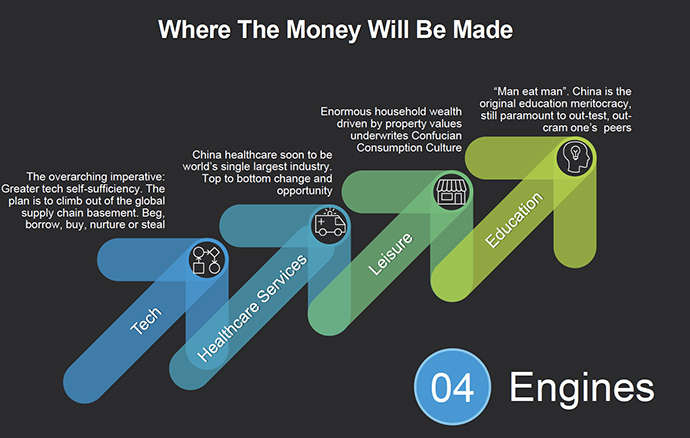China Merchants Steams in to Compete with SoftBank’s Vision Fund — Financial Times
–
China Merchants Group has been adopting new technology to resist foreign competitors for nearly 150 years. Founded in the 19th century, the company brought steam shipping to China so it could compete with western traders.
Now an arm of the Chinese state, CMG has been enlisted once again to buy up technology at a time when global private equity is vying for a share of China’s burgeoning tech market.
The country’s largest and oldest state-owned enterprise, CMG said this month it would partner with a London-based firm to raise a Rmb100bn ($15bn) fund mainly focused on investing in Chinese start-ups.
The China New Era Technology Fund will be launched into direct competition with the likes of SoftBank’s $100bn Vision Fund, as well as other huge investment vehicles raised by top global private equity houses such as Sequoia Capital, Carlyle, KKR and Hillhouse Capital Management.
“They have been very important to China in the past, especially in reform,” said Li Wei, a professor of economics at Cheung Kong Graduate School of Business in Beijing. “But you haven’t heard much about them in technology . . . It’s not too surprising to see them moving into this area, upgrading themselves once again.”
CMG is already one of the world’s largest investors. Since the start of 2015 its investment arm China Merchants Capital, which will oversee the New Era fund, has launched 31 funds aiming to raise a combined total of at least $52bn, according to publicly disclosed information.
But experts say little is known about the returns of those funds, most of which have been launched in co-operation with other local governments or state companies.
Before New Era, China Merchants Capital’s largest fund was a Rmb60bn vehicle launched with China Construction Bank in 2016. While almost no information is available on its investment activity, the fund said it would focus on high-tech, manufacturing and medical tech.
–
–
CMG’s experience investing directly into Chinese tech groups is limited, although it has taken part in the fundraising of several high-profile companies. In 2015 China Merchants Bank joined Apple, Tencent and Ant Financial to invest a combined $2.5bn into ride-hailing service Didi Chuxing, a company that now touts an $80bn valuation. It also invested in ecommerce logistics provider SF Express in 2013.
Success in Chinese tech investing is set to become increasingly difficult as more capital pours into the sector.
“Fifteen billion dollars can seem like a droplet in China,” said Peter Fuhrman, chairman and chief executive of tech-focused investment banking group China First Capital, based in Shenzhen. “We’re all bobbing in an ocean of risk capital. Still, one can’t but wonder, given the quite so-so cash returns from China high-tech investing, if all this money will find investable opportunities, and if there weren’t more productive uses for at least some of all this bounty.”
CMG, however, has always set itself apart from the rest of the country’s state groups. It is unlike any other company under the control of the Chinese government as it was founded before the Chinese Communist party and is based in Hong Kong, outside mainland China. Recommended Banks China Merchants Bank accused of US discrimination
The business was launched in 1872 as China Merchants Steam Navigation Company, a logistics and shipping joint-stock company formed between Chinese merchants based in China’s bustling port cities and the Qing dynasty court.
Mirroring its New Era fund today, it was designed to compete for technology with foreign rivals. At that time it was focused on obtaining steam transport technology to “counter the inroads of western steam shipping in Chinese coastal trade”, according to research by University of Queensland professor Chi-Kong Lai.
Nearly a century later, after falling under the control of the Chinese government, CMG became the single most important company in the early development of the city of Shenzhen, China’s so-called “window to the world” as it opened to the west.
Then led by former intelligence officer and guerrilla soldier Yuan Geng, the company used its base in Hong Kong to attract some of the first investors from the British-controlled city into the small Chinese town of Shenzhen, which has since grown into one of the world’s largest manufacturing hubs.
–
Its work in opening China to global investment gained CMG and Yuan, who led the company until the early 1990s, status as leading figures in the country’s reform era.
Today the company is a sprawling state conglomerate with $1.1tn in assets and holdings in real estate, ports, shipping, banking, asset management, toll roads and even healthcare. The company has 46 ports in 18 countries, according to the state-run People’s Daily, with deals last year in the sector including the controversial takeover of the Hambantota terminal in Sri Lanka and the $924m acquisition of Brazilian operator TCP Participações.
CMG did not respond to requests for comment. But one person who has advised it on overseas investments said the Chinese government was using it in the same way the company opened up Shenzhen to the outside world, helping “unlock foreign markets”.
–
–
https://www.ft.com/content/e7e81928-7f57-11e8-bc55-50daf11b720d
-phttps://www.ft.com/content/e7e81928-7f57-11e8-bc55-50daf11b720ds://www.ft.com/content/e7e81928-7f57-11e8-bc55-50daf11b720d































 Â
 